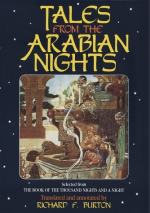The first volume dated “Benares: MDCCCLXXXV: Printed by the Kamashastra Society for Private Subscribers only,” did not appear till September 12, ’85: it had been promised for March and had been delayed by another unavoidable detention at Trieste. But my subscribers had no further cause of complaint; ten tomes in sixteen months ought to satisfy even the most exigent.
No. i. volume was accompanied by a circular earnestly requesting that the book might not be exposed for sale in public places or permitted to fall into the hands of any save curious students of Moslem manners. Yet the birth of the first-born was accompanied (I am fain to confess) with no small trouble and qualms to the parent and to all who assisted at the parturition. Would the “little stranger” robed in black and gold, the colours of the Abbaside Caliphs, with its brick-red night-cap after the fashion of ecclesiastical bandings, be kindly welcomed or would it be regarded as an abortion, a monster? The reader will readily understand how welcome to an author in such perplexity came the following article from the Standard (September 12), usually attributed to the popular and trenchant pen of Mr. Alfred Austin. I must be permitted to quote it entire, because it expresses so fully and so admirably all and everything I could desire a reviewer to write. And the same paper has never ceased to give me the kindest encouragement: its latest notice was courteous and appreciative as its earliest.
The first volume of Captain Burton’s long-expected edition of the “Arabian Nights” was issued yesterday to those who are in a position to avail themselves of the wealth of learning contained in this monumental labour of the famous Eastern traveller. The book is printed for subscribers only, and is sold at a price which is not likely to be paid by any save the scholars and students for whose instruction it is intended. But though the Benares “Kamashastra Society” are careful to let the world know that the “Thousand Nights and a Night” is not “published” in the technical sense of the term, the pages which will be read by a thousand purchasers may be fittingly regarded as the property of the world at large. In any case, the day when the experience of a life was embodied into this fresh translation of the “Alf Laylah wa Laylah” marks a distinct stage in the history of Oriental research. The world has had numerous versions of these stories. For at least a century and a half they have delighted old and young, until Shahrazade and Dunyazade, the Fisherman and the Jinn, and the tales told by the Tailor, the Kalendar, the Nazarene broker, and the Hunchback. . . to say nothing of Aladdin, Ali Baba, Sinbad the Sailor, and Camaralzaman and Badoura—seem like the most familiar of friends. Yet many of those who know the ordinary epitome prepared for the nursery and the drawing-room have little idea of the nature of the original. Galland’s abridgment was a mere shadow of the Arabic. Even the editions




